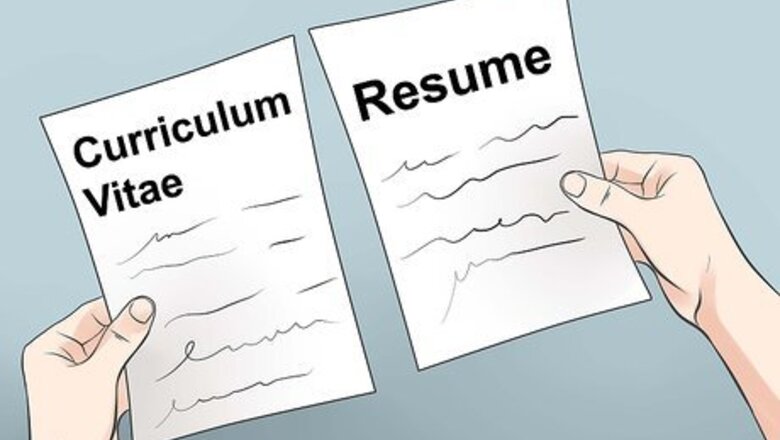
views
Understanding the Differences Between Resumes and CVs
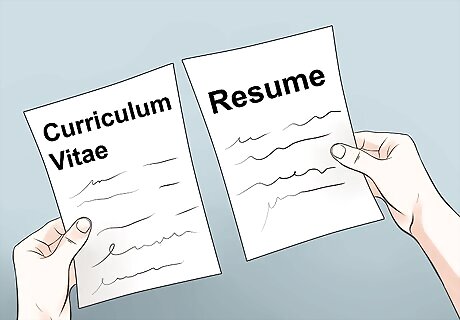
Understand the definition and purpose of a CV and a resume. Understanding the meanings of each word can help in defining the purpose of these similar, yet different documents. "CV" stands for curriculum vitae and is a Latin phrase meaning “course of life”. As the definition implies, it is a detailed account of your entire professional life thus far and will include as much information as possible, to give a full understanding of what you have accomplished. The word “resume” has French origins and means “to sum up”. As with any summary, a resume is a shorter, more concise description of your professional career as it relates to the job you are applying for. Resumes are meant to be briefly looked over to get a general understanding of your capability. Make yourself stand out by showing them everything they would want to read and eliminating information they will not care about.

Know when to use a CV and a resume. Knowing when to use a true CV versus a resume can be tough because many people use these terms synonymously. However, with a little information, you can decide which type of document to submit for the job you want to apply to: CV - Use a CV when it is either directly requested by the employer, when you are applying to a position in a country that uses CVs (throughout Europe, Asia, Africa and Middle East) or when you are applying in the US and Canada for jobs in the scientific, research, academia or medical fields. Resume - Use a resume when you are applying for jobs in the US and Canada (other than fields listed above requiring CVs) and other countries that choose to accept a resume over a CV. You can research the job application requirements for each country before submitting your application.
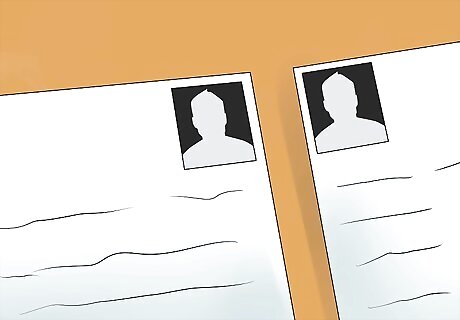
Understand that CVs and resumes have different levels of detail. CVs are more detailed than resumes. In accordance with the definition of a CV, more detail is required to inform employers of your entire history. On the other hand, a resume is a summary. While it still must provide details about your experience and education, it must be written in a concise manner with only the most relevant information presented. For a CV, details in a CV can include exact names of courses taken while obtaining a degree, all your publications, and details about specific projects and their outcomes. For a resume, you can choose which information is most relevant to include by reading through and understanding the job positing for the position you are seeking and then looking over your resume while asking yourself, “Is this information or experience necessary to do the job?” If the answer is “no” chances are the recruiter won’t care and you should leave it off your resume.
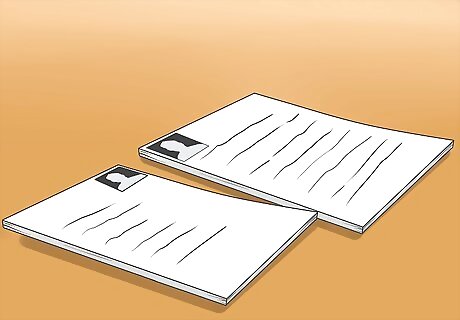
Know that resumes and CVs are usually different lengths. With different levels of detail comes different lengths. CVs are not bound by length and can even go beyond 10 pages because they include far more sections than a resume (publications, research projects, education courses, etc.) and more details about each job task or project. Resumes, as with any summary, must be kept short and sweet while still being effective. While there is much controversy on how short a resume should be, let’s not define the number of pages, but say it is best to keep it as short as possible while still providing all the necessary information to help you get an interview. This means understanding the type of person the company you are applying to is looking for and only keeping information in your resume that will help you market yourself as the right person for that job.
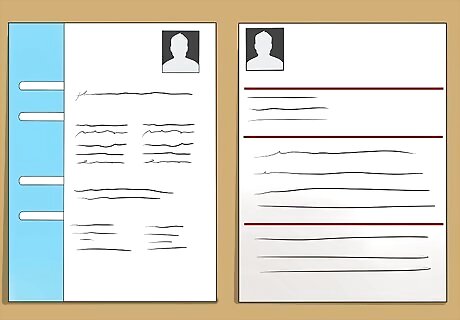
Keep in mind that the style of writing will differ. The sentences in CVs can be written in a more detailed and complex manner. Resumes on the other hand are most effective when written in short and effective sentencing using action words. For example, in a a resume you could write “Increased efficiency by 25% by implementing new process procedures”. However, in a CV you could write “Tasked with finding inefficiencies within the department to resolve and implement new process procedures. Researched and implemented new procedures over a 6 month time frame to eventually realize a 25% increase in efficiency. These two sentences describe the same thing, but you can see how a CV would explain the situation more than a resume which focuses on what you did and the results in a brief summary.
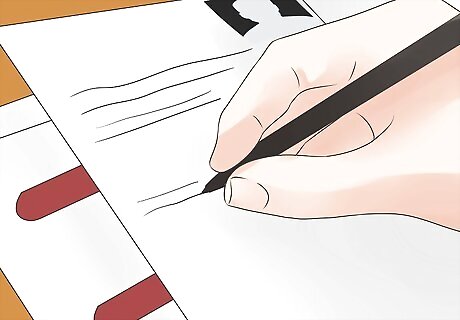
Keep CVs detailed and resumes strictly relevant. As mentioned previously, CVs provide the reader with the most details about your experience and education. To some extent, these details may not be exactly relevant to the job you are applying for. A resume must be limited to strictly relevant information that will help you get the job, so it is best to write your resume in a clear and concise manner that showcases why you are the best candidate for the job in the least amount of words possible. For example, listing all your publications versus only the ones that are most eye-catching to that employer.
Including Required Information for a CV
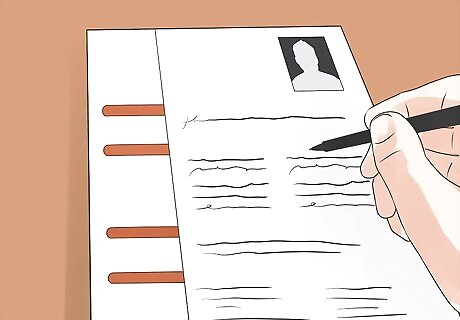
Include identifying information. This can include name, address, phone number, and email. Before applying to different countries, check personal information requirements as they may vary. For example, you may need to provide your marital status, national origin or picture.
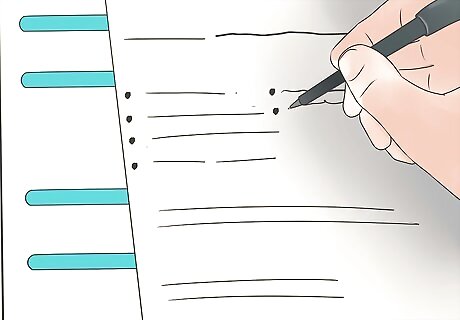
Make sure to include all relevant educational information. You can choose to provide course names and GPA in addition to the degree, institution and dates attended. On a resume, this would be the most educational information ever needed, but on a CV you can include more, such as: Dissertation or thesis. Describe your work and research along with names of advisors. Awards, honors, fellowships, scholarships and grants. Provide details of each of these types of honors including what you did to achieve them. Special training and certifications. List names, dates and institutions for training and certifications not associated with your formal education. Academic service. This includes committees and clubs you contributed to in your university.

Provide details of your experience. You can choose to list them all chronologically or break them down into subsections such as “Academic projects”, “Field Experience”, “Research”, etc. While listing, include name of company, title, dates of employment and all tasks, projects and special accomplishments.

Include creative work, publications, and presentations to provide a well-rounded picture of your academic career. List all publications and works you have either written yourself or contributed to. Add all presentations and public speaking engagements including topic, institution or event, and date. When listing, provide all authors’ names, title, journal, inclusive pages, and year. Do not add any works that have not been accepted or were just submitted.

Include supplemental information. Since you have almost unlimited space on a CV, include any supplemental information that paints a picture of your professional or academic life. Any additional information that could catch the ye of a recruiter or hiring manager should be included. Memberships or professional affiliations. Any affiliations outside of a university, preferably those that are nationally or internationally recognized. Community service/volunteerism. Show what you do in your spare time and how you choose to give back to your community. Languages. List all languages and your proficiency in each. References. Provide name, title, company and contact information.
Including Required Information for a Resume
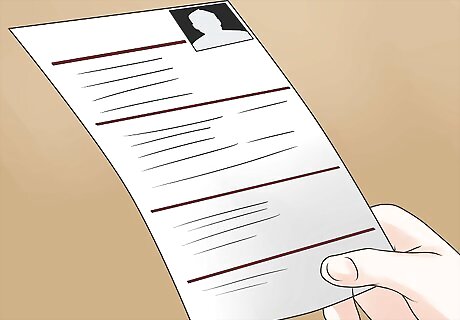
Include identifying information. This can include name, address, phone number, and email. Before applying to different countries, check personal information requirements as they may vary. For example, you may need to provide your marital status, national origin or picture.
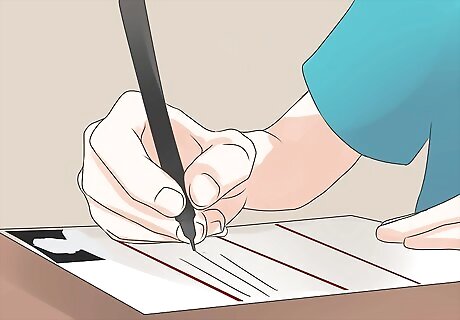
Provide the title of the position you are seeking. Distinguish which position you are seeking and your intention to prove your qualifications. This will allow the recruiter to immediately know what position you are seeking. Many large companies get a variety of applicants for every position, and they may have multiple positions open at the same time. Providing the title of the position you are seeking will help make sure your resume gets filed in the appropriate places.
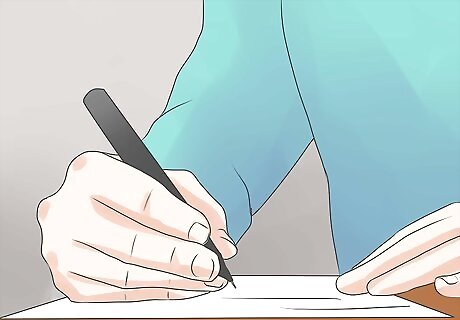
Write and include a summary statement. This section is a very brief, 3 to 5 sentence paragraph that highlights your skills, experience and accomplishments as it relates to the job. Summary statements are a good way to provide the hiring individual with an idea of why you would be a good fit for the job, without requiring them to analyze your resume too deeply.
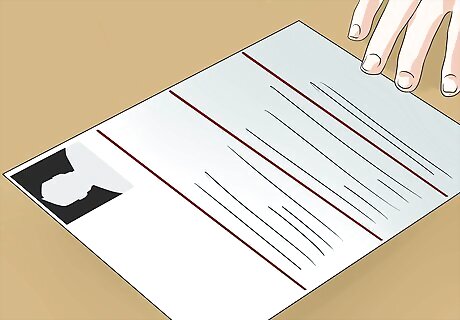
Include details regarding your core competencies/key skills. List all relevant skills that you have and are required to do the job successfully. Listing all of these skills will enable you to sell yourself well to a potential employer, providing them with an easy to read list of your talents. For example, Marketing Strategy, SEO, Problem Solving, Negotiations, Verbal and Nonverbal Communication Skills.

Provide your professional experience. Provide the company name, title, years of employment, and brief descriptions of tasks and accomplishments for each job held up to the last 10 years. Write each task using action verbs such as “trained” or “evaluated” followed by a brief description of what was done and what the results were. For example, “Developed business relationships across southeast territory to increase sales by 30% in 6 months”.

Detail your education, training and certifications to provide background information. List all relevant education, training and certifications that will be helpful for you to get the job. These qualifications can be critical, depending on the industry you want to work in. For example, if you are applying for a nursing position, list your bachelor’s degree and any certifications such as CPR. Being certified in project management (PMP) would not be relevant in this case and should not be listed in your resume.
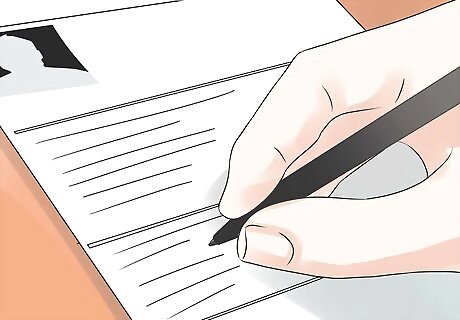
Provide optional sections only if they are relevant. You can choose to include additional sections such as, significant honors and awards, memberships or professional affiliations, community service/volunteerism roles and/or language skills. As mentioned previously, you can find out if any of these sections are relevant enough to add to your resume by reviewing the job description and understanding what is truly valued by the employer. For example, if you are applying for a role at a nonprofit organization, they may be more interested to see what community service and volunteer organizations you are involved with as opposed to a for-profit organization.

Don’t short change yourself when writing your resume. There are many misconceptions regarding the length of a resume and what it should entail. To keep it simple, if the information is relevant to the job you are applying for (if it is in the requirements or qualifications section of the job posting) add it to your resume. For example, as mentioned previously, a list of languages is typically written in a CV but not in a resume. However, if you are fluent in Japanese and you know the position you are applying to will have contacts in Japan, you should list your Japanese language skills in your resume.



















Comments
0 comment